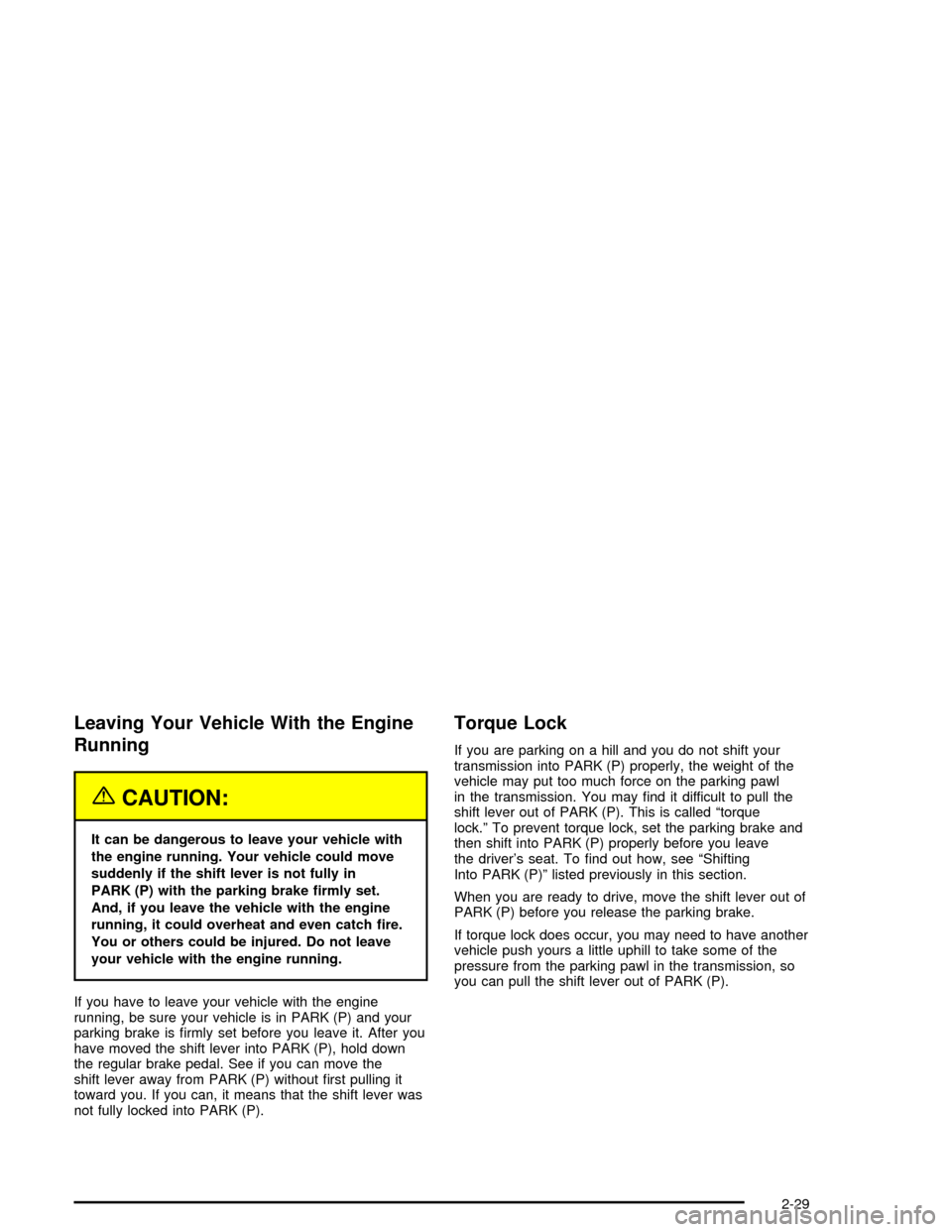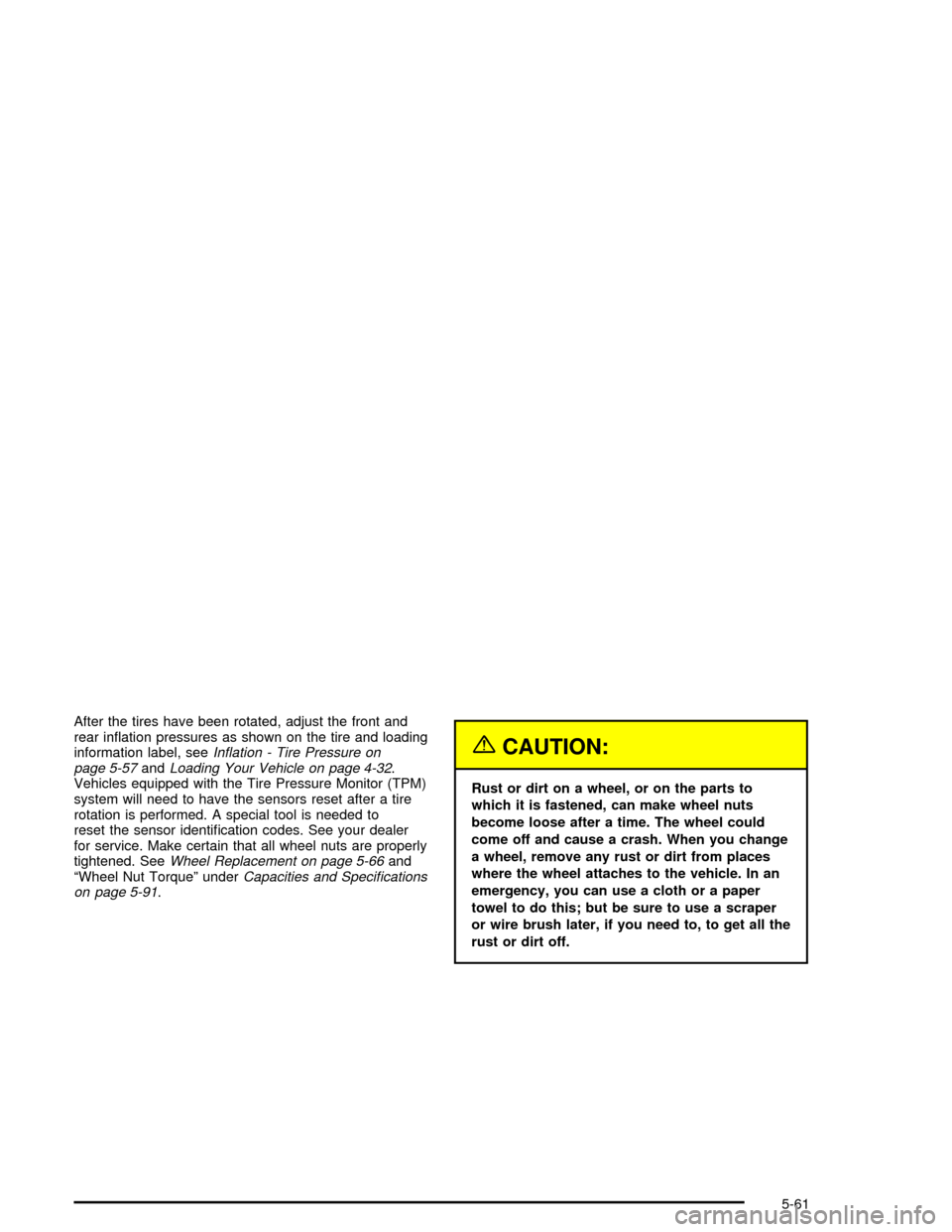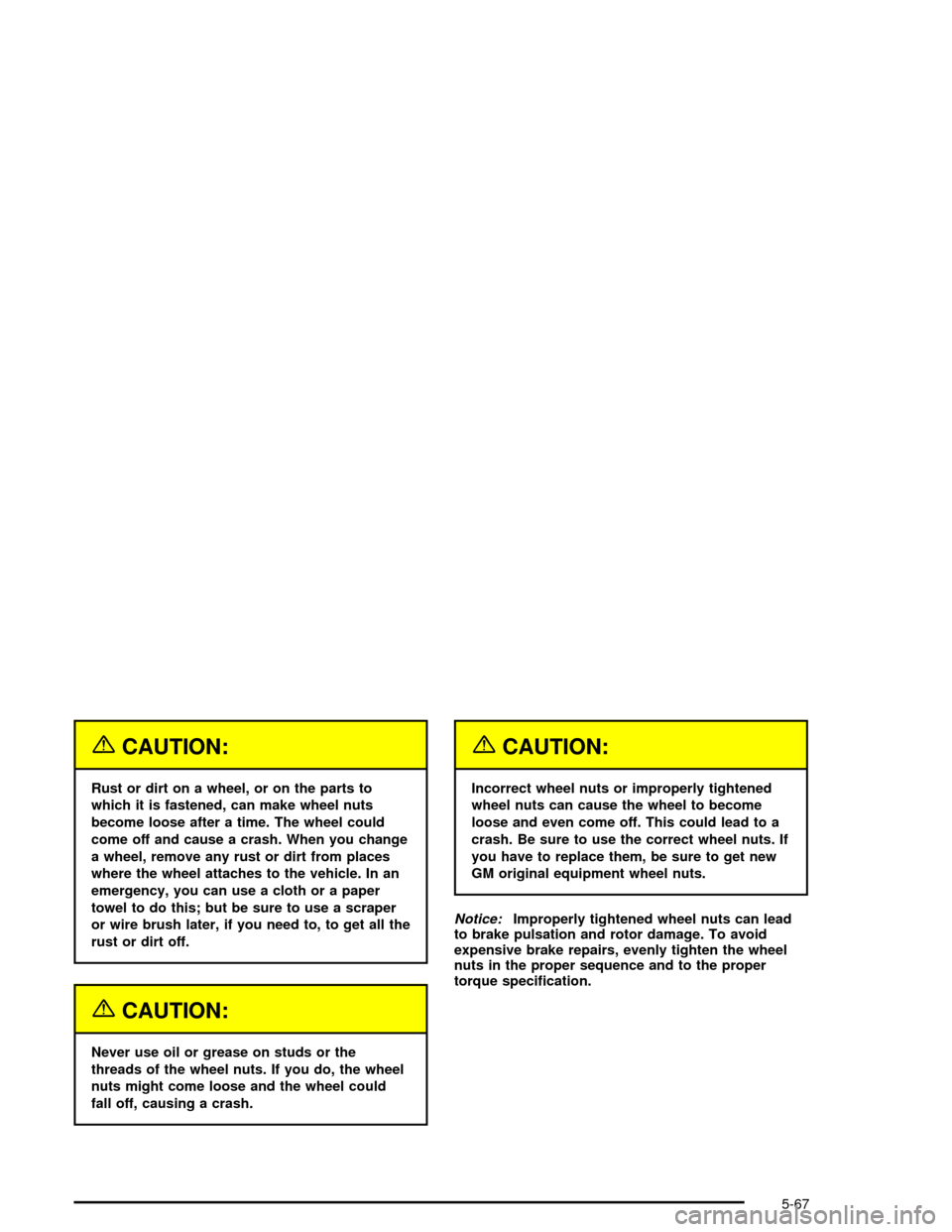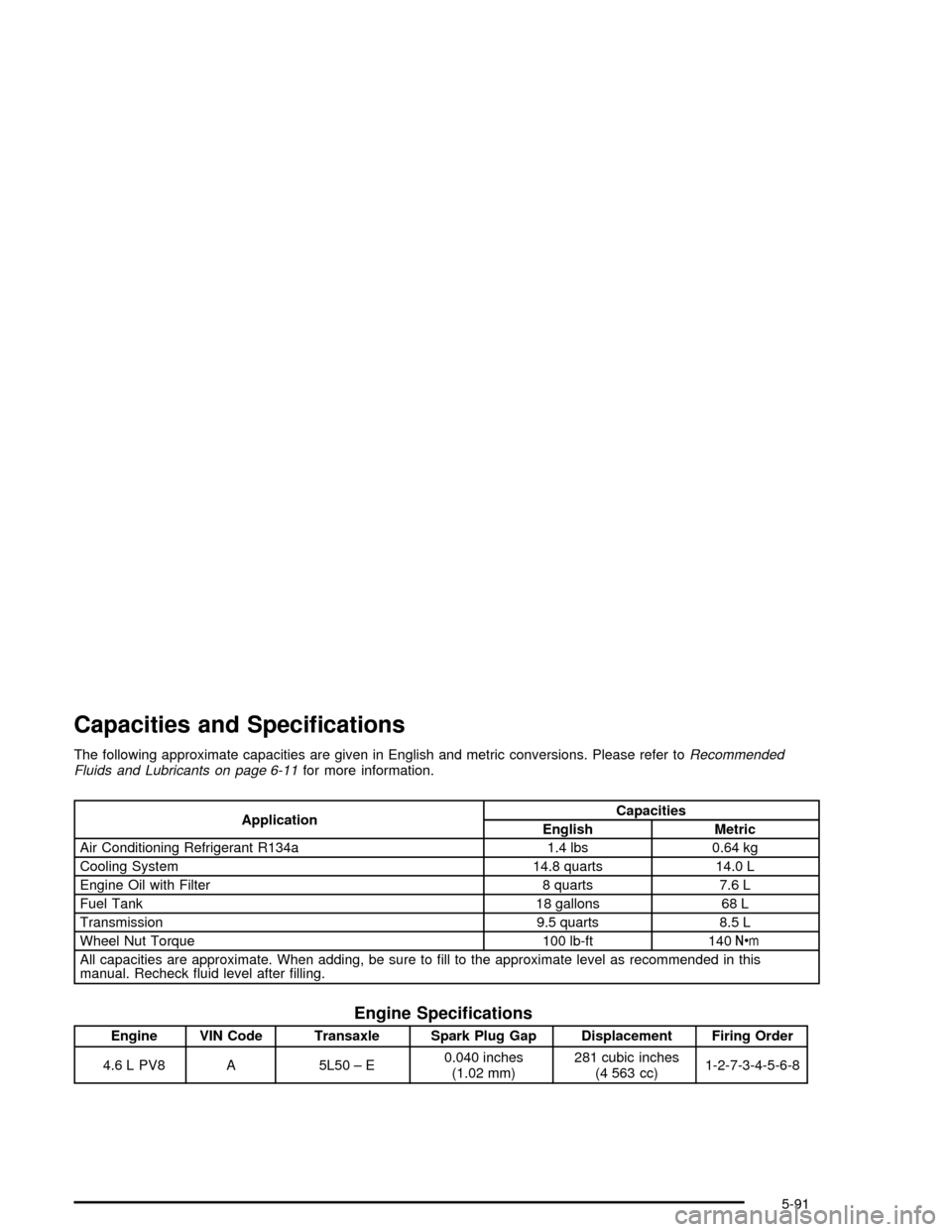torque CADILLAC XLR 2004 1.G Owners Manual
[x] Cancel search | Manufacturer: CADILLAC, Model Year: 2004, Model line: XLR, Model: CADILLAC XLR 2004 1.GPages: 356, PDF Size: 2.36 MB
Page 85 of 356

Leaving Your Vehicle With the Engine
Running
{CAUTION:
It can be dangerous to leave your vehicle with
the engine running. Your vehicle could move
suddenly if the shift lever is not fully in
PARK (P) with the parking brake ®rmly set.
And, if you leave the vehicle with the engine
running, it could overheat and even catch ®re.
You or others could be injured. Do not leave
your vehicle with the engine running.
If you have to leave your vehicle with the engine
running, be sure your vehicle is in PARK (P) and your
parking brake is ®rmly set before you leave it. After you
have moved the shift lever into PARK (P), hold down
the regular brake pedal. See if you can move the
shift lever away from PARK (P) without ®rst pulling it
toward you. If you can, it means that the shift lever was
not fully locked into PARK (P).
Torque Lock
If you are parking on a hill and you do not shift your
transmission into PARK (P) properly, the weight of the
vehicle may put too much force on the parking pawl
in the transmission. You may ®nd it difficult to pull the
shift lever out of PARK (P). This is called ªtorque
lock.º To prevent torque lock, set the parking brake and
then shift into PARK (P) properly before you leave
the driver's seat. To ®nd out how, see ªShifting
Into PARK (P)º listed previously in this section.
When you are ready to drive, move the shift lever out of
PARK (P) before you release the parking brake.
If torque lock does occur, you may need to have another
vehicle push yours a little uphill to take some of the
pressure from the parking pawl in the transmission, so
you can pull the shift lever out of PARK (P).
2-29
Page 283 of 356

After the tires have been rotated, adjust the front and
rear in¯ation pressures as shown on the tire and loading
information label, see
In¯ation - Tire Pressure on
page 5-57andLoading Your Vehicle on page 4-32.
Vehicles equipped with the Tire Pressure Monitor (TPM)
system will need to have the sensors reset after a tire
rotation is performed. A special tool is needed to
reset the sensor identi®cation codes. See your dealer
for service. Make certain that all wheel nuts are properly
tightened. See
Wheel Replacement on page 5-66and
ªWheel Nut Torqueº underCapacities and Speci®cations
on page 5-91.
{CAUTION:
Rust or dirt on a wheel, or on the parts to
which it is fastened, can make wheel nuts
become loose after a time. The wheel could
come off and cause a crash. When you change
a wheel, remove any rust or dirt from places
where the wheel attaches to the vehicle. In an
emergency, you can use a cloth or a paper
towel to do this; but be sure to use a scraper
or wire brush later, if you need to, to get all the
rust or dirt off.
5-61
Page 289 of 356

{CAUTION:
Rust or dirt on a wheel, or on the parts to
which it is fastened, can make wheel nuts
become loose after a time. The wheel could
come off and cause a crash. When you change
a wheel, remove any rust or dirt from places
where the wheel attaches to the vehicle. In an
emergency, you can use a cloth or a paper
towel to do this; but be sure to use a scraper
or wire brush later, if you need to, to get all the
rust or dirt off.
{CAUTION:
Never use oil or grease on studs or the
threads of the wheel nuts. If you do, the wheel
nuts might come loose and the wheel could
fall off, causing a crash.
{CAUTION:
Incorrect wheel nuts or improperly tightened
wheel nuts can cause the wheel to become
loose and even come off. This could lead to a
crash. Be sure to use the correct wheel nuts. If
you have to replace them, be sure to get new
GM original equipment wheel nuts.
Notice:Improperly tightened wheel nuts can lead
to brake pulsation and rotor damage. To avoid
expensive brake repairs, evenly tighten the wheel
nuts in the proper sequence and to the proper
torque speci®cation.
5-67
Page 313 of 356

Capacities and Speci®cations
The following approximate capacities are given in English and metric conversions. Please refer toRecommended
Fluids and Lubricants on page 6-11for more information.
ApplicationCapacities
English Metric
Air Conditioning Refrigerant R134a 1.4 lbs 0.64 kg
Cooling System 14.8 quarts 14.0 L
Engine Oil with Filter 8 quarts 7.6 L
Fuel Tank 18 gallons 68 L
Transmission 9.5 quarts 8.5 L
Wheel Nut Torque 100 lb-ft 140Y
All capacities are approximate. When adding, be sure to ®ll to the approximate level as recommended in this
manual. Recheck ¯uid level after ®lling.
Engine Speci®cations
Engine VIN Code Transaxle Spark Plug Gap Displacement Firing Order
4.6 L PV8 A 5L50 ± E0.040 inches
(1.02 mm)281 cubic inches
(4 563 cc)1-2-7-3-4-5-6-8
5-91
Page 354 of 356

T
Tachometer....................................................3-41
TCS Warning Light..........................................3-46
Telescopic Steering Column, Power Tilt Wheel...... 3-5
Testing the Alarm............................................2-18
Theft-Deterrent, Radio.....................................3-71
Theft-Deterrent System....................................2-17
Theft-Deterrent Systems...................................2-17
Tire
Pressure Light.............................................3-48
Tire Sidewall Labeling......................................5-50
Tire Size Codes..............................................5-52
Tire Terminology and De®nitions........................5-53
Tires.............................................................5-50
Buying New Tires........................................5-63
Chains.......................................................5-68
If a Tire Goes Flat.......................................5-73
In¯ation - Tire Pressure................................5-57
Inspection and Rotation................................5-60
Lifting Your Vehicle......................................5-69
Pressure Monitor System..............................5-58
Run-Flat.....................................................5-56
Uniform Tire Quality Grading.........................5-64
Wheel Alignment and Tire Balance.................5-65
Wheel Replacement.....................................5-66
When It Is Time for New Tires......................5-62To Use the Engine Coolant Heater....................2-22
Top Strap......................................................1-27
Torque Lock...................................................2-29
Towing
Recreational Vehicle.....................................4-32
Towing a Trailer..........................................4-37
Your Vehicle...............................................4-32
Traction
Control System (TCS).................................... 4-9
Control System Warning Light.......................3-46
Limited-Slip Rear Axle..................................4-10
Magnetic Ride Control..................................4-10
Stabilitrak
žSystem......................................4-11
Transmission
Fluid, Automatic...........................................5-19
Transmission Operation, Automatic....................2-23
Transmission, Transaxle, Transfer Case Unit
Repair Manual............................................7-11
Transportation Options...................................... 7-7
Trip Computer
Oil Life Indicator..........................................3-70
Trip Odometer................................................3-41
Trunk............................................................2-11
Trunk Lock Release........................................2-12
Turn and Lane-Change Signals.......................... 3-6
Turn Signal/Multifunction Lever........................... 3-5
Twilight Sentinel
ž............................................3-24
12